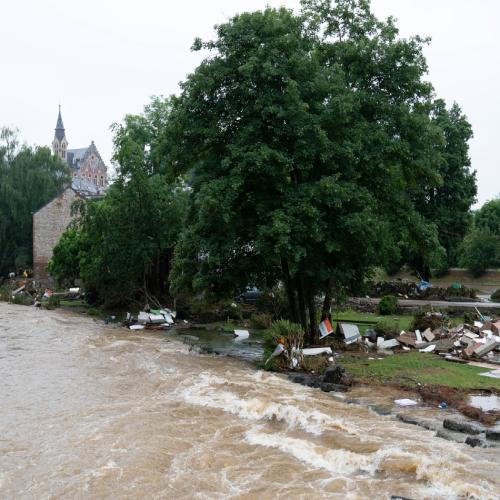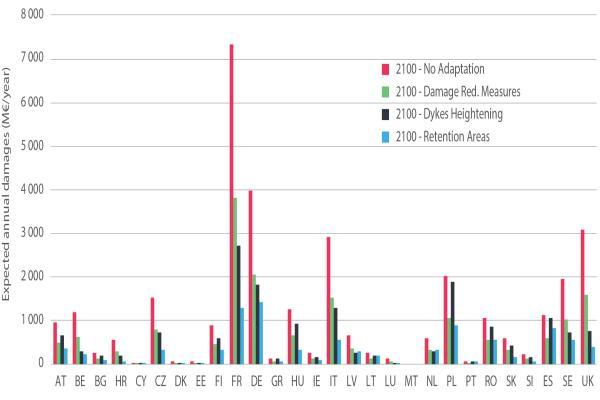
Flooding
Flooding is a natural hazard that may be seriously affected by changed land use and climate change. Floods are expected to become even more frequent and severe in the coming future.


River flooding is one of the most common and costly disasters to affect Europe. Due to climate change, it is projected that the European river basins of the Po, Duero, Garonne, Ebro, Loire, Rhine and Rhone will experience an increase in extreme floods, with a current return period above 500 years. Building on floodplains directly increases the risk of these areas flooding.


The NatCatSERVICE database reports that between 1980 and 2017, floods and landslides caused nearly EUR 160 billion in damages across the EU Member States. PESETA IV estimates that the economic losses due to flooding could be even larger, however, at EUR 7.8 billion annually for river flooding and EUR 1.4 billion for coastal flooding.
Urban sprawl increases the risk of pluvial (flash) flooding by reducing water retaining surfaces and ground absorption, increasing water runoff. The impermeable materials of cities cause soil sealing (JRC Repository), which is as high as 80 % in some cities, but averages at 40–60 % in others. Moreover, projections for the effects of climate change estimate that local precipitation events (rain) will become more frequent and intense (EEA Assessment Indicator), which will worsen flash floods.
Climate-related extreme events are happening more frequently, with particularly sharp rises in hydrological events. Increased flooding in Europe is therefore expected as one of the worsening impacts of climate change.
Storm surge floods usually occur during winter and are caused by coastal storms. Mean sea levels and the intensity of storm surges are expected to rise in the coming decades due to climate change, increasing the risk of coastal flooding in Europe (CLIMAT ADAPT Report). This could affect up to half of the EU’s population who live less than 50 km from the sea.
France and the UK account for half of the annual economic losses from coastal flooding; the total loss averages EUR 1.4 billion per year.
Although flooding is a natural hazard, flood risk may worsened by human impacts like changed land use and is likely to be seriously affected by climate change.
Compound flooding is a cumulative problem that occurs when large runoff from heavy rain (which causes river flooding) can combine with storm surges (which causes coastal flooding) to create compound flooding. The impact of this can be worse than the individual floods. Low-lying coastal areas are at a high risk of compound flooding.
Flooding may also be aggravated by dry periods, where soil water retention is decreased by prolonged lack of moisture, which increases water runoff when precipitation does occur and leads to floods. Dry periods and drought are expected to become more frequent due to climate change.
Based on 2018 national risk assessments of EU Member States, the ‘Overview of natural and man-made disaster risks the European Union may face’ outlines the major risks that can affect Europe. It provides information that can help to prevent loss of life, mitigate disruptions and damage to infrastructure, and reduce the frequency of future risks.
Although flooding is listed among the lowest fatality rate risks in Europe, it is the most frequent and costliest disaster to affect Europe each year, as it may trigger cascading effects. Flooding remains the most common risk within the national risk assessments, with all EU Member States acknowledging it. The cross-border impact of flooding is also significant, with more than half of river basins being cross-border. Alongside river flooding, some Member States also identified coastal floods and sea level rise, as well as pluvial flooding (also known as flash flooding) as significant risks.
According to the 2020 PESETA IV report, flooding will become more frequent and more severe by 2100 if global temperatures rise by 3 °C or more above pre-industrial levels. The Intergovernmental Panel on Climate Change’s (IPCC) Special Report on global warming of 1.5°C above pre-industrial levels, along with the reports of IPCC Working Groups I and II, demonstrates that the consequences of 1°C of global warming triggers more extreme weather, rising sea levels and diminishing Arctic sea-ice.
In July 2021, catastrophic floods took place in Germany, Luxembourg and Belgium, causing deaths and widespread damage. Precipitation was most intense in the east of Belgium, with 271.5 mm (10.69 inches) of rain over 48 hours in province of Liège. Record-breaking 93 mm of rain fell over a single day around Germany's Ahr and Erft rivers, while 106 mm fell over two days in Belgium's Meuse region.
The European Environment Agency (EEA) reports that catastrophic coastal flooding and flash floods will occur more frequently throughout Europe because of an expected rise in mean sea levels and increasingly intense storm surges within the coming decades.
The 2007 EU Floods Directive (Directive 2007/60/EC) was pivotal in documenting and assessing flood risks affecting Member States so that they could be addressed. The three requirements of the Directive were that:
Comparison of the national risk assessments shared with the Commission in 2015 and 2018 reveals that Member States have increased focus on flooding events besides fluvial floods (i.e. coastal and pluvial/flash floods) and covered a wider range of extreme weather scenarios. The EU Floods Directive has produced new information on flooding by collecting data on flood events, but the EU lacks an agreed methodology for how to record the negative economic effects of flooding.
Flood risk management plans (FRMPs) developed by EU Member States for 2015–2021 have already resulted in the development of European flood protection measures. In Germany, for example, improvements made to the flood protection structures along the Elbe helped to reduce (and in some places prevent) damage from flooding in 2013 which was similar in magnitude to the destructive floods of 2002. Despite all Member States setting objectives for managing flood risks, the Commission recommended that they refine their analysis and set out clear budgetary commitments in the second round of FRMPs.
Industrial farming and food systems remain one of the key drivers of climate change. The EU’s 2020 Farm to Fork strategy aims to break the vicious cycle of the industrial food system accelerating climate change by promoting sustainable farming. The strategy addresses the worsening impacts of flood damage through improved food security and increased resilience of the food system.
Among the many reports on flooding, the following are of particular note:
The European Regional Development Fund and Cohesion Fund provide significant funds for investments in preventing and preparing for extreme weather in Member States. The European Agricultural Fund for Rural Development (EAFRD) implements the common agricultural policy and provides financial support to farmers to restore agricultural production that has been damaged and aims to introduce preventative measures designed to reduce the impact of floods.
Under the ‘Climate change adaptation action’, the LIFE programme provides grants for best practice, pilot and demonstration projects that contribute to increased resilience to climate change.
The European Floods Awareness System (complemented by the Global Flood Awareness System) alerts Member States to potential flood risks up to ten days in advance. The Copernicus Emergency Management Service provides emergency services and disaster risk management bodies with fast and accurate forecasts of European and global floods to ensure adequate flood response, prevention, preparedness, and recovery operations.